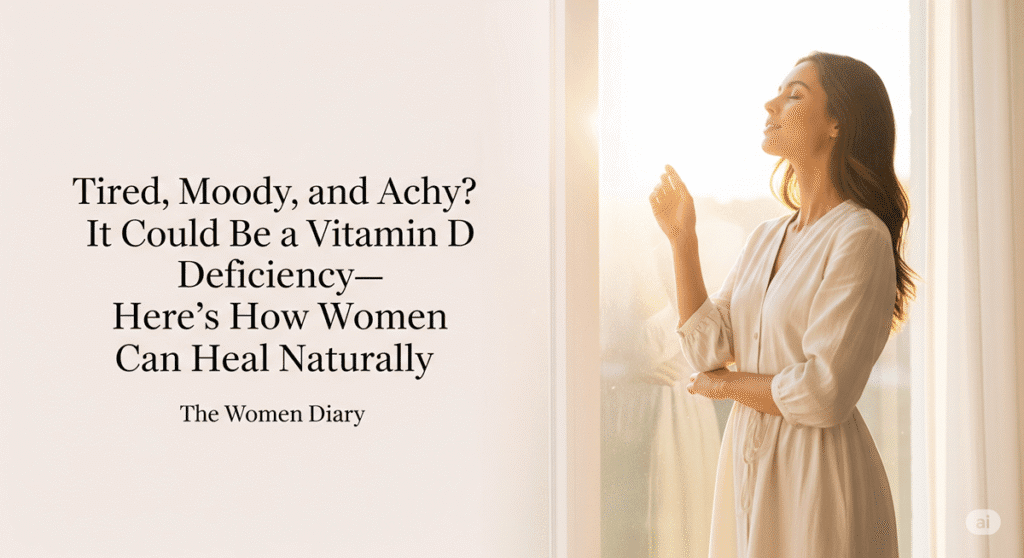Is It Just Fatigue—Or Something More?
We all feel tired now and then. Between careers, family, social commitments, and self-care (if there’s time left), modern women juggle a lot. But when that exhaustion becomes chronic—paired with mood swings, muscle weakness, or even increased hair fall—it may not be just “burnout.” It could be your body waving a red flag for Vitamin D deficiency.
Surprisingly, despite the abundance of sunlight in countries like India, studies show that up to 70% of urban Indian women are deficient in Vitamin D (Nair & Maseeh, 2012). This is not just about weak bones—it’s about immunity, hormones, energy, and mood regulation.
Let’s decode the signs and explore how you can heal naturally—without turning your routine upside down.

The Subtle Symptoms Most Women Overlook
Vitamin D deficiency doesn’t always shout; it whispers. Here are a few signs to keep on your radar:
- Persistent fatigue even after a full night’s sleep
- Mood changes or depression—especially seasonal dips
- Aching bones and muscles
- Hair thinning or excessive hair fall
- Frequent colds or infections
- Low immunity and slow wound healing
- Brain fog or poor concentration
Many of these symptoms are brushed off as “normal,” especially by working women or moms. But research published in The Journal of Clinical Endocrinology & Metabolism found a clear correlation between low Vitamin D levels and symptoms like fatigue, low mood, and muscle weakness.
Why Are Women at Higher Risk?
From hormonal fluctuations to lifestyle constraints, several factors put women—especially between 25 to 45 years—at increased risk:
- Less sun exposure: Indoor work life, sunscreen use, or air pollution in cities limits natural Vitamin D synthesis.
- Pregnancy and breastfeeding: These stages deplete Vitamin D stores rapidly.
- Diets low in fortified foods or dairy: Many women avoid dairy or animal-based foods, missing key sources.
- Darker skin tones: Melanin reduces the skin’s ability to produce Vitamin D from sunlight.
Healing Naturally: Smart, Subtle Shifts
You don’t need to pop endless pills or drastically change your lifestyle. Here’s a luxury-meets-practical guide to restoring your Vitamin D levels:
- Soak in the Morning Sun—Strategically
Early morning sunlight (before 10 a.m.) is your golden ticket. Just 15–20 minutes of direct exposure on arms and legs, 3–4 times a week, is often enough. Don’t use sunscreen during this short window—but do moisturize afterward.
- Add Vitamin D-Rich Foods to Your Diet
While natural food sources are limited, here are some potent ones:
- Fatty fish like salmon, mackerel, and tuna
- Egg yolks
- Fortified dairy or plant-based milks
- Mushrooms exposed to sunlight (yes, really!)
- Cod liver oil (in moderation)
Consider blending a morning smoothie with fortified almond milk, a handful of nuts, and banana for a nutrient-packed start.
- Choose the Right Supplements—Mindfully
If blood tests confirm low levels, your doctor may recommend a Vitamin D3 supplement (cholecalciferol). Opt for high-quality, certified brands, and always take it with a meal containing fat for best absorption.
- Enhance Absorption with Magnesium
Did you know Vitamin D needs magnesium to be activated in the body? Add spinach, dark chocolate, pumpkin seeds, and avocados to your meals to boost magnesium naturally.
- Embrace Functional Wellness
From infrared saunas that boost circulation and recovery, to Ayurvedic herbs like Ashwagandha that help with hormonal balance, explore holistic methods that align with your self-care rituals. Luxury doesn’t have to mean complicated—it means intentional.
Don’t Self-Diagnose—Test and Act
If you’re experiencing multiple symptoms, speak with your healthcare provider and request a 25-hydroxy Vitamin D blood test. It’s the only way to know for sure. Ideal levels range between 30 to 50 ng/mL, but anything below 20 is considered deficient.
Treating a deficiency without a test can lead to overdosing—which has its own complications. Think of your wellness like skincare: personalized, not one-size-fits-all.
The Bottom Line
Women are often conditioned to tolerate fatigue, mood swings, and pain as normal. But your body is constantly communicating with you. When something feels off, it usually is. Vitamin D deficiency is more common than we think—but also more manageable than we’re told.
By combining natural sunlight, mindful eating, and science-backed supplements, you can reclaim your energy, improve your mood, and support your long-term health—all with intention and elegance.
Remember, wellness is not just about surviving the day—it’s about thriving in it.
References
- Nair, R., & Maseeh, A. (2012). Vitamin D: The “sunshine” vitamin. Journal of Pharmacology & Pharmacotherapeutics, 3(2), 118–126.
- Schleicher, R. L. et al. (2016). Vitamin D status and its relation to health outcomes. American Journal of Clinical Nutrition, 104(3), 611S–619S.
- Holick, M. F. (2007). Vitamin D deficiency. New England Journal of Medicine, 357(3), 266–281.
Read More on Health, Wellness & Beauty Here:
-
 Book Review: Mother Mary Comes to Me by Arundhati Roy — A Testament to Resistance, Memory, and Womanhood
Book Review: Mother Mary Comes to Me by Arundhati Roy — A Testament to Resistance, Memory, and Womanhood -
 From Girlhood to Womanhood: How Our Relationship With Birthdays Changes Over Time
From Girlhood to Womanhood: How Our Relationship With Birthdays Changes Over Time -
 Hyper-personalized Beauty Routines Using AI and AR Technology
Hyper-personalized Beauty Routines Using AI and AR Technology -
 India’s Golden Moment: The Women Who Conquered the World Cup 2025
India’s Golden Moment: The Women Who Conquered the World Cup 2025 -
 2025 Trending Halloween Costumes You’ll See Everywhere
2025 Trending Halloween Costumes You’ll See Everywhere






